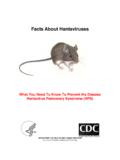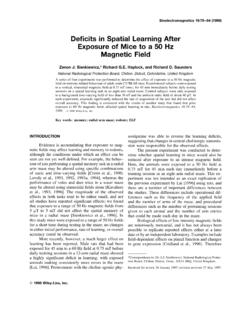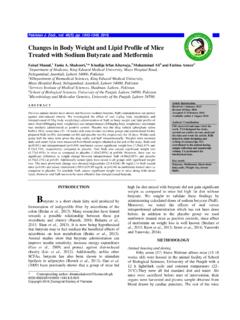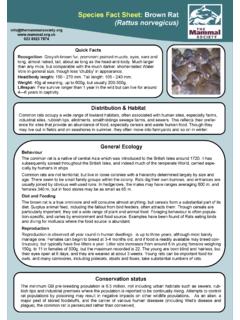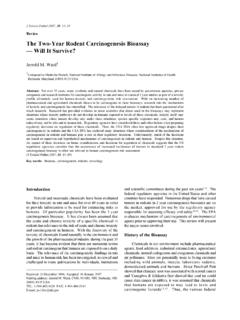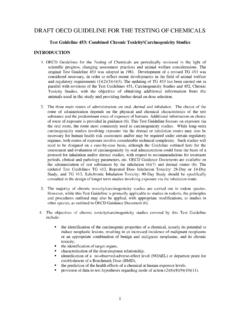Transcription of General code of practice for controlling rats and …
1 General code of practice for controlling rats and miceInspectionEquipment requirements: A conventional torch with good batteries and a spare bulb, apocket notebook or a clipboard, PPE including overalls, a dust mask, safety shoesand gloves as appropriate need to be 5 principles of rat and mouse control Stop them coming in. Stop them moving around Deny them shelter and harbourage Deny them food Prevent them from breeding During a service visit for rats and mice the most importantaspect is inspection, this must be methodical. Equal attentionis given to: upper areas, such as ceilings voids, dead spaces,wall cavities, service ducts, riser cupboards, lift shafts andcellars. Equally spend time noting the adjacent and externalsurroundings to gain even more valuable information. Ratsand mice can be found in many circumstances so alwayshave an open mind regarding the seat or point of The first step is to carry out the surveyWhat is the species infesting the premises?
2 How wide is the distribution?How large is the infestation?What is the site history, are there supporting records oftreatment, what recommendations have been made and whatprevious action has been taken?What work has been carried out on the premises to proofagainst rodents in the past?Where are the most obvious harbourages?How reliable and what sightings have been logged by sitestaff?Are there any known water sources if there is a ratinfestation?What are the food sources; can this source be eliminated orcontrolled?Is there an issue regarding waste management?Where is the infestation coming from? A)Is it in suppliers goods? B)Is it via the fabric and services? C)Is it endemic?D)How can re-infestation be controlledE)Is there any threat posed to non-target species?A) NeighboursOn every site inspect prior the area prior to applyingrodenticides and the carrying out the initial treatment:Establish who are the next-door neighbours on both sidesand where appropriate who is above, below and out a risk assessment to ascertain any probableinfestation.
3 Are there any domestic premises adjoining whererodents could be feeding, you might have difficulty gettingaccess to these. Which adjoining premises could be involvedin catering or have foodstuffs stored that could supportrodents? Which premises are suitable for rodents breeding,they could be living and breeding in one premises andfeeding next door. Build up a scenario of the immediate areaand if necessary draw a simple sketch. Are neighbours placing refuse on the pavements or in a yardthat could attract rodents? Are neighbouring emptyproperties supporting infestation? Are there local reports ordo you have knowledge of others nearby with problems thatwill help build up a picture?B) EXTERNAL SERVICES AND SURROUNDINGSA ssess the premises being covered from the outside prior tointernal inspection. Ensure that you are familiar with its extent.
4 Establish if there are any ofthe following: -Communal refuse storage area - Waste compactors andskips - Dustbin areas or roomsService cupboards or plant - boiler - plenum roomsDisused or derelict property adjacent or nearby - Wasteland or overgrown areasAre there any low growing shrubs planted which could beproviding cover?Railway and other embankmentsIs there loose rubble about, are there stonewalls?Is the ground soft or a hard apron around buildings?Streams, brooks, rivers, canals, ponds, lakes andwatercoursesIs there a refuse tip or landfill site nearby?Is there a sewerage treatment plant nearby?Are there any mine workings, tunnels, caves or undergroundpassages in the vicinity? Are people fly tipping?Is there any old machinery, equipment or lumber storedwhich will afford harbourage?Is demolition work being carried out nearby?
5 Are buildings being refurbished or constructed nearby?Is there work being carried out on services such as gas,electricity, water or sewers? C) External fabricWhat is the General condition of the fabric of the building?What defects are there: -Holes, missing bricks, masonry, Missing drain covers andservices covers? Are airbricks defective? Is there any evidence of building shrinkage (internal orexternal)?Are any holes evident around pipes and services entering thebuilding?Are there any uncovered ducts? Are there any overhead pipes or services connectingbuildings?Are drain down pipes defective allowing access up intoguttering and eaves?Are there any gaps evident under doors and between doors?D) Internal defects and conditionsAre there: -Disused lift shafts or a dumb-waiter shaft in the building?Riser cupboards going through the building?
6 What is the General condition of the internal fabric of thebuilding? General holes and cracks and crevices? Are there any missing bricks and defective bricks? Masonry defects? Poor coving and gaps beneath tiles?Missing drain covers?Is there any evidence of building shrinkage? Holes around pipes and services entering the building? Are there any gaps evident under doors and between doors?Is there stud wallingVoids and dead spaces caused by shop fitting /refurbishmentand refitsIs there a suspended ceiling?Do the ceiling tiles push out for access into this voidWhat services pass through walls from neighbouringbuildings?2) Signs of infestationSightingsHave there been any sightings, which could positivelyidentify a species on the premises. Recent dead bodies willgive a reasonable indication that infestation is still in the daytime may indicate that a large populationmay exist or that harbourages have been disturbed.
7 Sightingsalone will not give an accurate level of infestation The size and shape of droppings will indicate the speciespresent and to some extent the age range of the populationwhether they are juveniles or adult. Bear in mind that brownrats may deposit up to 40 spindle shaped droppings dailyand house mice approximately 50- 80 droppings. If thesedroppings are glistening and shining this could indicate anactive infestation. In dryer warm environments they becomedull or matt after a few materialsRats produce a distinct serrated edge whilst a smootheredge is produced when mice gnaw on products. Damagedgrain can easily be identified, because rats tend to leave cutor half grains whilst mice nibble all around the grain leavingthe core and grain husks. This is sometimes known askibbling. The presence of droppings alone is not a goodindication of current activity because these may be old andnot been cleaned away.
8 Observe for other signs such asfootprints in dust, gnawing, nest materials etc. If there are alarge quantify always insist that old droppings are number these should be removed at the time of thesurvey and treatment. Look for chewed paper, cardboardand plastic also. Electrical wiring /alarm wiring, water andgas pipes are vulnerable to and mice do have a distinctive smell which somedescribe as a stale odour while others describe it asreminiscent to biscuits . The odour remains sometimes longafter rodents have been brought under are formed from the sediment contained in urine beingdeposited and often consist of grease from the animalscoats, dirt and debris. These pillars are often an indication oflarge long established use habitual routes or runs and a dark colouredsmear or deposit left by grease from Their fur will eventuallybuild up as they brush against surfaces.
9 These are normallyfound around holes or along pipes, up walls, along beamsand girders and even on bait monitors. Smears in the form ofloops beneath exposed ceiling rafters or joists will indicaterat activity, a continual pattern indicates brown rats and abroken pattern suggests black are sometimes found stuck around the entrance toholes and burrows, evidence of a thriving materialThis is often composed of paper, cardboard, cellophane,plastic, wool, feathers and fur and can be in a dead space,under fixtures and fittings, deep inside stock or betweenbags or boxes stacked on a pallet. Rat runs and rat burrows are easy to see and are usually found onembankments, sloping banks, in ditches and are usuallypartially disguised by nearby logs, stones and excavated from the site will indicate a system ingeneral use. Conversely cobwebs over the entrance to aburrow or hole, grass or weeds growing over a hole orcovering a run will denote that it is not in use.
10 All rat burrowsystems need to be filled in after treatment to see ifre-infestation or occupancy takes pet might denote residence of a rat or mouse in a premisesand their attention to a certain area might give an earlywarning of activity. Rodent control and eradication service procedures1.) Rats- External site boundary and buildingperimeter ) Gassing burrows and fumigation When it comes to fumigation there are four distinctivemethods in use today. It can be a very effective butpotentially hazardous method for the operative. It is alwaysthe most effective method when employed. I. Use of a fumigant in outdoor burrows Ii. The fumigation of stacks and commodities undergas proof sheets or in containers Iii. The fumigation of buildings and silos Iv. The fumigation of aircraft, barges and ships holds I. The use of a fumigant in outdoor burrowsThe most common method is to use the tableted aluminiumphosphide preparation, which is formulated in 3gm material is very toxic and liberates a toxic andflammable gas when exposed to water.


